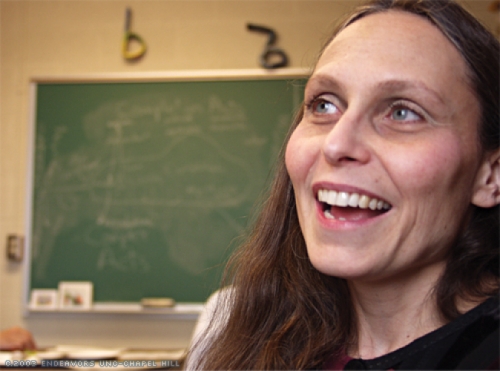Without the Internet, their research would be impossible. Without the lunchtime team meetings in front of a chalkboard covered in diagrams, it wouldn’t be as much fun. Laura Janda whizzes through her latest brainstorm (she says she hasn’t slept much all week because she keeps coming up with new ideas), covering her diagrams with dots and arrows, and switching between speaking Russian and English. Her graduate students are on the edges of their seats, ready to respond. But what are they so excited about?
Grammar. Janda works on aspect, a grammatical category in many Slavic languages, including Russian. Aspect has to do with how people conceptualize time. It’s complicated. Hyug Ahn, a master’s student, says that even most native Russian speakers can’t explain what aspect is or how it is used. And Janda says, “You can go through entire books of lists explaining when to use different aspect, and it looks grotesque because they seem totally unmotivated, just this random horror.”
But aspect doesn’t have to be so difficult. “It’s a myth that the divisions of grammatical categories are infinite and chaotic. They are actually quite finite and well ordered,” she says. But no one has ever explained that to students. Janda has a lot of ideas about exactly how these categories are organized, and her research is helping her develop new tools for teaching Slavic languages to non-native speakers.
Janda’s method includes using rocks, sand, blocks of wood, and ping-pong balls to explain the complexities of aspect and other Slavic grammatical categories, which require adding a marking to every noun, pronoun, and verb in a sentence to indicate relationships among objects and ideas. “A lot of the categories have never been described even by theoreticians very well,” Janda says. “And it’s hard to teach them to students. It’s painful, actually.” According to Janda, it’s possible to spend several years learning a Slavic language and still not know the meaning of some sentences.
But with her rocks and sand, aspect begins to make sense. For example, two rocks can never occupy the same space, but two piles of sand can easily be mixed. The two rocks represent sequencing — when two things happen one after the other, requiring the perfective aspect. The two piles of sand mixed together represent simultaneity, which uses the imperfective aspect. Or say you embed a rock in a pile of sand — one thing happens (the perfective aspect) as another is going on in the background (the imperfective aspect). Students get it, and it’s fun.
Sean Flanagan, a first-year graduate student, is helping Janda test her method by surveying native Russian speakers who live in North Carolina. The thirty-two questions he uses require the subjects to identify which configurations of blocks of wood and sand best represent the use of verbs in a sentence. He and Janda want to find out, as Flanagan says, “Is this just a nice model that helps us explain to students pedagogically how aspect works, or is this a real connection that’s happening in the minds of native speakers?”
Dealing with differences in cultural background has put an interesting twist on his survey. Flanagan says that Russians’ love for working puzzles conflicted with the purpose of the survey — to find out whether native Russian speakers conceptualize aspect in the same way that Janda has explained it. “I think every single person I interviewed told me that it was set up wrong. I would tell them that there are no right or wrong answers, and that was very frustrating for a lot of them,” Flanagan says.
The vocabulary Janda and her students are studying and categorizing is huge. “If all the words that are used were put in dictionaries, the dictionaries would be bigger than this room,” Janda says half-jokingly to the graduate students in her office. Part of testing her theory involves finding good examples of the myriad ways that verbs are used and examining how they fit into Janda’s system.
And that’s where the Internet comes in. Search engines make it possible to search a huge amount of data for specific words and phrases in Russian. The team uses the examples for the interviews and in the online Slavic language resources they are creating, so Janda doesn’t want just anything. Anne Keown, a doctoral student, says, “[Janda] likes a certain type of sentence for her examples — something that can stand the test of time, something that can stand alone without any significant context.”
Still, they search a wide range of resources. Flanagan has found information from Russian professional wrestling web sites and voodoo instruction manuals, for example. And the language used on the Internet is spontaneous — it’s the way people really talk. The students have found verb usages on the Internet that they never would have found in a dictionary.
So far, the findings lean in favor of Janda’s concept of categorization, but they plan to test their methods further. As Flanagan says, “It’s not enough to simply come up with something theoretically. The closer we get to what’s actually going on in speakers’ heads, the better we’ll be able to teach these languages to other people.”
And now, the sandwiches and cookies are gone, the blackboard is covered with chalk, and Janda has finished explaining her latest brainstorm. It’s time to get to work.
Mary Alice Scott was formerly a staff writer for Endeavors.
Janda, professor of Slavic linguistics, received the Dr. A. Ronald Walton Award for “a career of distinguished service” by the National Council of Less Commonly Taught Languages. She also won a Faculty Fellowship for Teaching with New Media, sponsored by the James M. Johnston Center for Undergraduate Excellence and the Institute for the Arts and Humanities, to continue her work developing books about Slavic grammatical categories. To view the books, visit the Slavic and East European Language Resource Center at www.seelrc.org. SEELRC is funded by the U.S. Department of Education.




